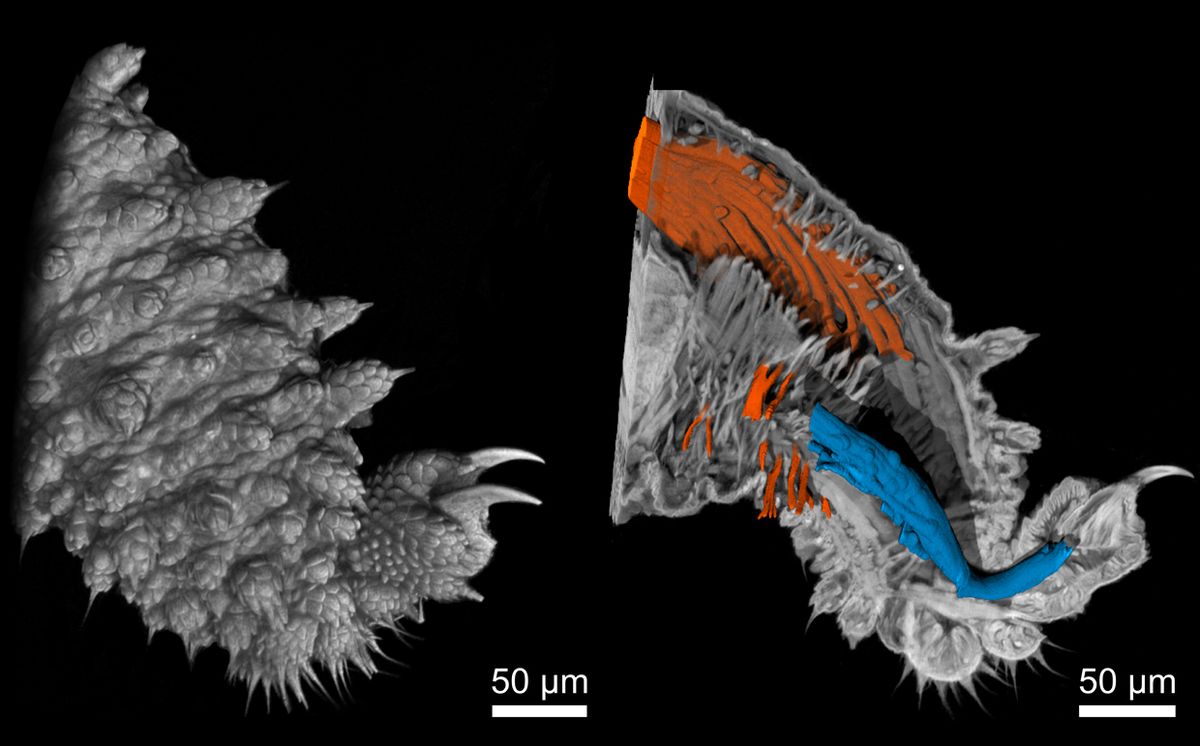Euperipatoides rowelli is ready for its closeup.
Biomedical physicists have used a new computed tomography (CT) machine to produce 400-nanometer-scale 3D images of a tiny limb of a newborn velvet worm to test the system’s ability to produce hyper-detailed scans of biological samples.
Such images could help scientists probe evolutionary linkages among fundamental and ancient animal species. Its inventors also hope it can illuminate fleshy features for medical applications such as tumor analysis.
The tabletop tomography setup was assembled by researchers at the Technical University of Munich, who discuss its pros and cons in a recent paper in the Proceedings of the National Academy of Sciences.
The system’s key advantage is that it employs a new type of X-ray tube produced in Sweden by manufacturer Excillum. It features a very thin water-cooled tungsten target sitting on a diamond layer. The thinner the target, the smaller can be the X-ray focal spot can be (up to a point).
Mark Müller, a physicist at the Technical University of Munich, says the X-ray tube’s ability to project a very small focal spot—and by small he means on the order of 200 to 300 nanometers—makes it possible for the machine to generate images at extremely high resolutions.
“The idea was to build an in-house system that can reach higher resolutions than commercially available devices,” he says.
With it, Müller and a group of fellow researchers in Franz Pfeiffer’s biomedical physics group created images of Euperipatoides rowelli showing singular muscle fibers. They built a 3D picture of the outside and inside of a worm limb with a resolution of 400 nanometers. The width of a human hair is 40 times that size.
These images have captured the attention of a velvet worm expert just a few hours away—Georg Mayer, who heads up the zoology department at the University of Kassel, also in Germany. He’s interested in arthropods, or animals with jointed legs, including spiders, crabs, and mantises, and how their limbs got to be that way.
Arthropods are ancient animals, but not as ancient as the velvet worm. With a lineage that dates back 500,000 years, it is also unique in being a worm that has legs. Mayer is exploring the evolutionary link between worms and arthropods, which may be reflected in the musculature of the velvet worm leg.
The images from Munich, Mayer says, can show Euperipatoides leg muscles at the level of single strands. “We want to compare the musculature arrangement in the limbs with that of arthropods,” he says. “From that, we hope to say this muscle evolved from that one, and this other one got lost.”
In order to produce a scan in their new machine, researchers place an object (in this case, the velvet worm) between the X-ray source, contained within the tube, and a detector. The sample under observation is placed very close to the focal spot, with maybe a millimeter between them. The source focuses a stream of electrons from the back of the tube onto the tungsten target. The resulting collision between the electrons and target scatters the X-rays, which then pass through the sample. The detector on the other side then picks up the image produced by the X-rays.
Because X-rays pass through most objects, they can create an image of almost anything placed between the source and the detector. By rotating their sample, the Munich crew constructed a 3D image of the velvet worm’s leg.
Mayer had already been examining worm images produced by the Deutsches Elektronen-Synchrotron, a particle accelerator outside of Hamburg. But the resolution of those images is not high enough to resolve single muscle fibers, and using a synchrotron is a rather expensive way to do worm research.
Müller says the advantage of the Munich system over other micro-imaging techniques is that it can quickly create high-resolution images without using more complex X-ray optics, which saves money. And, because it doesn't require samples to be cut into small sections, as does confocal laser-scanning microscopy, the tissue is preserved.
Euperipatoides is more than just legs (although its jaws, slime papillae, and antenna are, technically speaking, modified forms of legs). Researchers at the Max Planck Institute of Colloids and Interfaces in Potsdam are also interested in how these other fibers form and reform, hoping they might point the way to making new kinds of recyclable materials.
All told, this is enough to take a closer look at the velvet worm. A much, much closer look.
Michael Dumiak is a Berlin-based writer and reporter covering science and culture and a longtime contributor to IEEE Spectrum. For Spectrum, he has covered digital models of ailing hearts in Belgrade, reported on technology from Minsk and shale energy from the Estonian-Russian border, explored cryonics in Saarland, and followed the controversial phaseout of incandescent lightbulbs in Berlin. He is author and editor of Woods and the Sea: Estonian Design and the Virtual Frontier.



